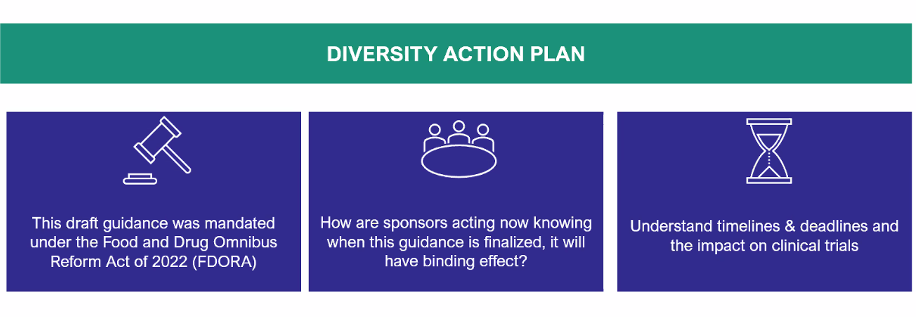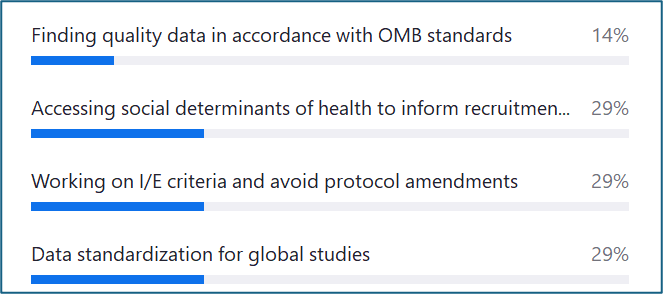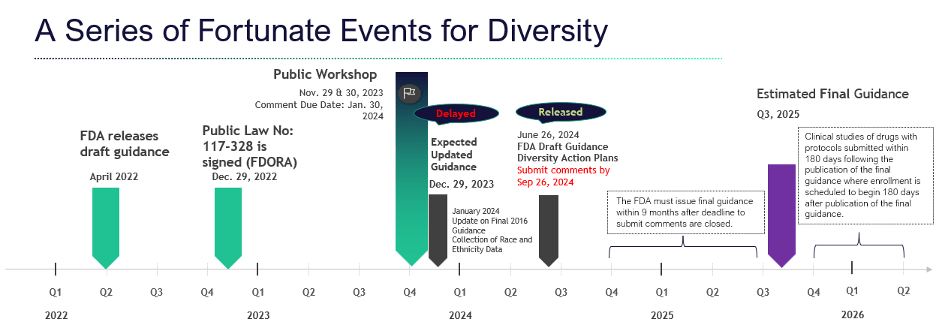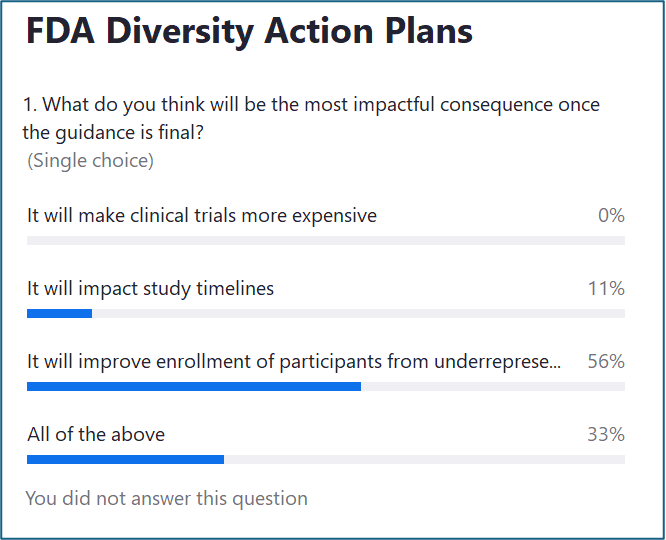FDA Diversity Action Plans: Deciphering the Guidance and its Consequences
Article
Clinical


“We all know that the topic of diversity is not new, and the FDA has released many other guidances in the past, so why is there so much pressure now?” asked Commercial Enablement Manager Lya Rebelo.
In a recent webinar sponsored by Vistatec, a global content services provider, Rebelo started the discussion with an overview of the US Food and Drug Administration’s (FDA) guidance on clinical trial diversity action plans.

In April 2022, the FDA released a draft guidance with the purpose of providing recommendations for developing a race and ethnicity diversity plan to enroll participants from underrepresented racial and ethnic populations, following revised Office of Management and Budget (OMB) standards. The revision combines separate race and ethnicity questions into one on patient questionnaires, with the sub-categories shown below. To reflect intersectionality, patients are asked to select as many of the following categories — including the new Middle Eastern/North African category — with which they identify:
Despite such efforts, sponsors face numerous challenges in increasing diversity in clinical trials. When attendees were asked to choose their greatest challenge, three of the four following areas proved equally challenging:

To answer the question she posed earlier, Rebelo said the pressure came once President Biden signed the draft guidance into law at the end of 2022. Under this law, sponsors are required to submit diversity action plans for Phase III or other pivotal studies.
However, Rebelo said the Food and Drug Omnibus Reform Act of 2022 (FDORA) requirements take those plans a step further, including enrollment by age group, sex, and other known demographic characteristics.
Updated guidance from the FDA was expected at the end of 2023 but was not issued until June of this year. The agency is accepting comments online until Sept. 26. Rebelo estimates the final guidance will be issued in Q3 2025. “What does this mean for sponsors? That means that now any clinical studies of drugs with protocols submitted within 180 days following the publication of the final guidance … must submit a diversity action plan,” Rebelo said.

Rebelo was joined on the webinar — moderated by Vistatec’s Karen Tkaczyk — by Joan Chambers, senior consultant with the Tufts Center for the Study of Drug Development (Tufts CSDD), and Aman Khera, vice president of regulatory science and innovation at Worldwide Clinical Trials. All agreed that the FDA mandate will help move the needle forward for equal representation in clinical trials, with Khera referring to it as a “welcome disruptor” in the industry.
Chambers shared her concerns about the final guidelines' actual impact on ongoing patient enrollment, retention, and strategy as a whole. Equally important, she noted, is the guidance's impact on existing relationships prior to June 2024. There is also the issue of trust. Culturally sensitive, relevant communication and representative staffing can help combat mistrust, she said.
“That [mistrust] is something that we know is a big elephant in the room,” Khera said.
Chambers also questioned how sponsors and CROs will operationalize it all, as the burden will fall to the study sites. “It funnels down to the investigative site and the site team,” she said.
Khera agreed. “If all the mandate has done is to push more pressure on sites, then we need to be smarter how we’re communicating and there needs to be more handholding. Sites are already overburdened.”
The panelists also noted that the approach to developing diversity action plans will vary based on the size of the organization. Large sponsors will have bigger budgets and more staff to devote to the task, while smaller sponsors will be more likely to outsource efforts.
Khera pointed out that many sponsors submitted diversity action plans following the April 2022 guidance. Those plans are now drafts. With the June guidance, she said, “We're in a gray zone. … Because clinical research has not halted, right? It's ongoing. And even though that you know we're going to get that switch flipped on” when the guidance is finalized.

Rebelo agreed. “This is not a checkbox exercise anymore. This is not ‘Oh, now I have done it, and that's it.’ This will be continuously happening. So this is a mindset shift. … This is not about copy-and-paste protocol inclusion/exclusion criteria anymore.” And it involves multiple stakeholders: patients, sites, sponsors, CROs.
She emphasized that diversity action plans are not just about race and ethnicity, but also looking at social determinants of health (SDOH), such as income, age, disability, level of education, and access to transportation. Sponsors also are looking at census, epidemiology, and real-world data (RWD). “How can this inform your recruitment strategies?”
Rebelo and Khera both noted that the FDA expects most diversity action plans not to exceed 10 pages. “We can't write novels,” said Khera. “We need to be smart, and we need to be concise.”
Given the ambiguity surrounding diversity action plans and delays in both updates and final guidance, webinar attendees were still optimistic about its effectiveness. Over half (56%) think the guidance will improve enrollment of underrepresented populations in clinical trials.

Rebelo said the FDA takes comments seriously, and implemented learning from a workshop held in November 2023. “I want to take this opportunity to remind you … that you can still submit your comments online by no later than September 26th,” she said. “I encourage you to have your say and make a difference.”
For additional resources on diversity in research, visit our Clinical Trial Diversity Hub.

Lya Rebelo
Commercial Enablement Manager
A seasoned Global Go-to-Market Manager with 16 years of experience in sales, product management, and marketing, underpinned by a solid background in Organic Chemistry. Adept at managing product marketing from branding to strategy, with extensive international experience interacting with manufacturing sites and sales offices worldwide. Known for a diligent, results-driven approach and exceptional interpersonal skills.